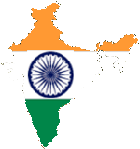| Things to do |
|
| Shopping |
| Beaches |
| Eating |
| Entertainment |
| Accomodation |
| Culture |
| Wildlife |
|
Goa State
Located on the West Coast of
India in Konkan, Goa is bounded by Maharashtra in the north, by
Karnataka in the east and the south, while the Arabian Sea forms its
western coast. Panaji (Panjim) is the state's capital and Vasco da Gama
(Vasco) is its largest city.
The merry land of beaches and sunshine, of feni and cashewnuts, of
hippies and -- , Goa has a historical past too. Until a century before
the arrival of the Portuguese adventurer, Vasco Da Gama (who landed
near Kozhikode in Kerala in 1498), Goa belonged to the kingdom of
Kadamba for over a thousand years. Over those years, it had been
successfully conquered by the Karnatakan Vijayanagars, the Muslim
Bahmanis and Yousuf Adil Shah of Bijapur but the capture of the fort at
Panaji by Alfonso De Albuquerque in 1510 signaled the start of a
Portuguese occupation that was to last for 450 years. Despite many
Goans glossing over the end of Portuguese occupation, the Portuguese
did not just hand over Goa to the Indians. For a detailed account of
the end of Portuguese rule and the liberation of Goa see Wikipedia Operation
Vijay
Goa formed part of the Mauryan
Empire in the 3rd century BC. This was followed by the rule of the
Satvahanas of Kolhapur and the Bhojas who made Chandor their capital.
From 580 – 750 AD the Chalukyas of Badami held sway over Goa until the
Silharas took control in 1086 AD.
Gulhalla Deva of the Kadambas, originally from Mysore, consolidated his
hold over Chandor in the 11th century AD until the 13th century AD. On
a pilgrimage to Somnath, a sudden storm threatened the Kadamba King and
his armada at the mouth of the River Zuari. Arab traders who lived in a
settlement by the riverside rescued them and in gratitude, the Arabs
were allowed to carry on their commercial activities in the kingdom.
Old Goa:
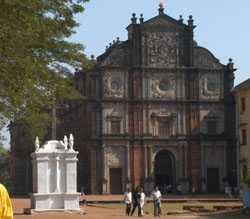
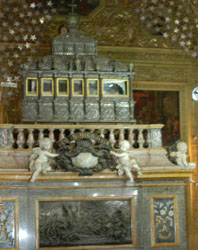 Old Goa was the State Capital
until 1843 when it moved down river to Panaji. Once a byword for
splendour, with a population of several hundred thousand, Old Goa was
virtually abandoned from the 17th century as the river silted up and a
series of malaria and cholera epidemics drove out the inhabitants. It
takes some imagination to picture the once-great capital as it used to
be. The maze of twisting streets, piazzas and grand Portuguese villas
have long gone; all that remains are a score of extraordinarily
grandiose churches and convents. Old Goa has been declared a World
Heritage Site by Unesco and today is the state’s main cultural
attraction. Tourists come here from the beach resorts to admire the
massive facades and beautiful interiors of the well-preserved churches.
The Tuscan St Catherine’s
Old Goa was the State Capital
until 1843 when it moved down river to Panaji. Once a byword for
splendour, with a population of several hundred thousand, Old Goa was
virtually abandoned from the 17th century as the river silted up and a
series of malaria and cholera epidemics drove out the inhabitants. It
takes some imagination to picture the once-great capital as it used to
be. The maze of twisting streets, piazzas and grand Portuguese villas
have long gone; all that remains are a score of extraordinarily
grandiose churches and convents. Old Goa has been declared a World
Heritage Site by Unesco and today is the state’s main cultural
attraction. Tourists come here from the beach resorts to admire the
massive facades and beautiful interiors of the well-preserved churches.
The Tuscan St Catherine’s
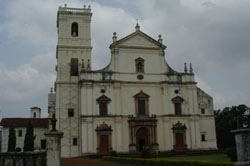 Cathedral is the largest church in India and took eighty
years to build, finally being consecrated in 1640. The scale and detail of the Corinthian-style
interior is overwhelming; huge pillars divide the central nave from the
side aisles, and no less than fifteen altars are arranged around the
walls. An altar to St Anne treasures the relics of the Blessed Martyrs
of Cuncolim, whose failed mission to convert the Moghul emperor Akbar
culminated in their murder, while a chapel behind a highly detailed screen holds the Miraculous Cross, which stood
in a Goan village until a vision of Christ appeared on it. Said to heal the sick, it is now kept in a
box; a small opening on the side allows devotees to touch it. Other sights worth seeing include
the Arch of the Viceroys, built in 1597 to commemorate Vasco da Gama’s
arrival in India, and the distinctive domed Church of St Cajetan
(1651), modelled on St Peter’s in Rome. Old Goa is a major draw for Christian pilgrims from all over India who come to visit the
tomb of St Francis Xavier, the renowned sixteenth-century missionary
whose remains are enshrined in the Basilica of Bom Jesus. Buses leave
regularly for Old Goa from Panjim. Alternatively visitors can hire an
auto-rickshaw or taxi.
Cathedral is the largest church in India and took eighty
years to build, finally being consecrated in 1640. The scale and detail of the Corinthian-style
interior is overwhelming; huge pillars divide the central nave from the
side aisles, and no less than fifteen altars are arranged around the
walls. An altar to St Anne treasures the relics of the Blessed Martyrs
of Cuncolim, whose failed mission to convert the Moghul emperor Akbar
culminated in their murder, while a chapel behind a highly detailed screen holds the Miraculous Cross, which stood
in a Goan village until a vision of Christ appeared on it. Said to heal the sick, it is now kept in a
box; a small opening on the side allows devotees to touch it. Other sights worth seeing include
the Arch of the Viceroys, built in 1597 to commemorate Vasco da Gama’s
arrival in India, and the distinctive domed Church of St Cajetan
(1651), modelled on St Peter’s in Rome. Old Goa is a major draw for Christian pilgrims from all over India who come to visit the
tomb of St Francis Xavier, the renowned sixteenth-century missionary
whose remains are enshrined in the Basilica of Bom Jesus. Buses leave
regularly for Old Goa from Panjim. Alternatively visitors can hire an
auto-rickshaw or taxi.
Panjim (Panaji)
 The
heart of the city is the Church Square or Municipal Garden with the
Portuguese Baroque Our Lady of the Immaculate Conception Church,
originally built in 1541. But as anybody will tell you, Panjim is a
walker’s paradise. There
are tree-lined avenues and promenades and the best possible walking
areas are any of the quiet winding lanes on Altinho. The
heart of the city is the Church Square or Municipal Garden with the
Portuguese Baroque Our Lady of the Immaculate Conception Church,
originally built in 1541. But as anybody will tell you, Panjim is a
walker’s paradise. There
are tree-lined avenues and promenades and the best possible walking
areas are any of the quiet winding lanes on Altinho.
Browse through the Panjim Corporation Market in Campal. You can get
everything here from local and exotic fruit and vegetables to fish. Buyers come to eye fat tiger prawns,
mackerel, kingfish, squid, crabs, pomfret, mussels, oysters... the list
is endless, and the odours rich. The Goan fisherwomen treat all
supplicants with equal disdain. There are also stalls selling clothing,
shoes, bags, electronic items, spices, flowers and sweets.
For branded shopping, head to colourful MG Road, which is also where
you’ll find all the liquor and wine shops. Also worth visiting is 18th
June Road another busy
shopping street with a marvellous Gujurati sweet mart where you can
find all manner of snacks including really tasty hot Samosas.
By far the most interesting
establishments are the posros, or the
small grocers that sell
everything, from fresh pao to ingots of golden palm jaggery, petals of
dried kokum, sheets of aromatic tamarind and bottles of home-made toddy
vinegar and coconut feni.
Spice Plantations
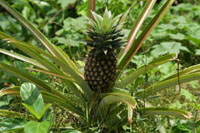
 There
are numerous spice plantations in Goa, offering guided tours which are
informative and friendly. Learn about the various spices, leaves and
their uses
and sample the food. In season you can see the Cashew Nut apple and
watch as Feni is distilled. Mainly located in the hills bordering Goa
and
Karnataka and on the road to Belgaum it is easy to combine a trip here
with Old Goa and the Shri Mangesh Temple for a great day out. Any taxi
driver should be able to take you on this trip, expect a cost of approx
Rs1500
There
are numerous spice plantations in Goa, offering guided tours which are
informative and friendly. Learn about the various spices, leaves and
their uses
and sample the food. In season you can see the Cashew Nut apple and
watch as Feni is distilled. Mainly located in the hills bordering Goa
and
Karnataka and on the road to Belgaum it is easy to combine a trip here
with Old Goa and the Shri Mangesh Temple for a great day out. Any taxi
driver should be able to take you on this trip, expect a cost of approx
Rs1500
Dudhsagar Waterfalls
Another
great day out is to the Dudhsagar Waterfalls. On the border of Goa and
Karnataka, here the Mandovi river falls 600m in a spectacular
waterfall, with a refreshing plunge pool at the foot. The pools are
only accessible via private jeep, keeping the numbers of tourists down
and giving a peaceful day out. Swim in the cool waters, watch the
friendly monkeys, have a picnic. The more adventurous can climb the
falls, but this is not for the feint hearted.

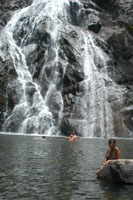
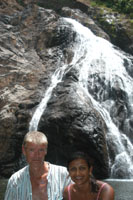
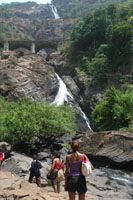
Allow a full day for this trip at a taxi fare
of about Rs1500. There are additional fees (about Rs350pp) to pay when
you get there.
Mapusa

If
there is something you want then Mapusa is the place to get it. A major
shopping and trading centre, with hundreds of small shops bursting to
the seams with goods for sale. If you are looking for the essence of
Goa, then Mapusa Friday Market is the perfect place for you. The town
of Mapusa has now become synonymous with its Friday Market, which is
located outside the Mapusa Municipal Market. Every Friday, the small
town of Mapusa burst into a riot of colour and noise. The farmers and
small entrepreneurs from all over Goa come to the market to sell their
locally grown or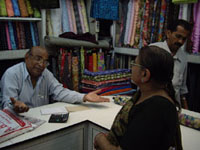 manufactured wares
and will even repair shoes on the
spot. Goan women dressed in their colourful attire also come in from
nearby villages to sell their self-made items including spices of
different types. You can shop for a wide range of items, right from
spices and T-Shirt to fresh fruit, trinkets, sausages, straw hats,
fresh and dried fish, incense, vegetables, souvenirs and furniture. You
should keep in mind that bargaining in Mapusa is an integral part of
shopping and therefore you should never pay the first price asked for. manufactured wares
and will even repair shoes on the
spot. Goan women dressed in their colourful attire also come in from
nearby villages to sell their self-made items including spices of
different types. You can shop for a wide range of items, right from
spices and T-Shirt to fresh fruit, trinkets, sausages, straw hats,
fresh and dried fish, incense, vegetables, souvenirs and furniture. You
should keep in mind that bargaining in Mapusa is an integral part of
shopping and therefore you should never pay the first price asked for.
Margao
Located in South Goa, Margao is the second biggest city in Goa, and possibly the
biggest city of Goa. It is certainly the busiest city, lively and full of crowds,
having one of the largest markets in Goa, with a huge variety of goods.
Margao is famous for beautiful churches, inviting parks, lovely houses,
beautifully built temples and especially for its huge closed market.
Even before the Portuguese entered Goa, Margao city was known for its
University having a library with
over 10,000 books.
This town square boasts of two
gardens - Municipal Garden and the Aga Khan Market. The other
attractions in the square are the statue of Luis de Menezes Braganca
and the Public library. The library is housed in the Municipal Building
and has books in various languages - Hindi, Marathi, Konkani, English
and Portuguese. You can just sit in and read a book of your choice with
no one to disturb you. The reading hall itself is open from 8 am to 8
pm.

Also known as the Largo da Igreja, the Church Square has the Church of
Holy Spirit as its prime attraction. The church was initially
constructed by the Jesuits in 1564, however shortly afterwards, the
army of Adil Shah marched in and destroyed it. Repairs were carried out
much later and took around 30 years to complete. Today, the church is
considered one of the best example of the Indian Baroque. Both the
interior and exterior of the church is worth seeing.
Margao is the probably the most
important railway station in the state of Goa. The Konkan trains, which
connect Goa to Mumbai and Mangalore, stop at Pernim, Thivim, Karmali
and Margao.
Anjuna
Anjuna is huge. So huge there’s a
South, Middle and North Anjuna beach. Much of the action, and many
hotels, bars and restaurants are clustered off North Anjuna Beach in
DeMello, Soronto and St Anthony vaddos. The road from Mapusa comes past
Mazil and Temb vaddos to end in DeMello Vaddo, where there’s a parking
area to the right. Lanes lead left from here to St Anthony’s Church,
beyond which stretches Gaunkar Vaddo and Middle Anjuna Beach, which has
its own share of beachfront shacks.
South
of Middle Anjuna is the large
flea market ground in Dando Vaddo, which leads on to Little (South)
Anjuna Beach. The flea market is a must do at least once experience. It
is held every Wednesday and thousands of stalls are set up to sell you
trinkets, clothes, bedspreads, ornaments, henna, food etc.
Arpora
Arpora village, spread across a hillock near Baga, is the place to be
on Saturday nights. Ingo’s night market is far more organised than
Anjuna’s flea market and can be much more fun. There are stalls
offering all kinds of goods and services, including clothes, trinkets,
spices, exotic haircuts, body-piercing, tarot-reading, palmistry, sculpture,
wood-carvings, and lots of food. With live bands playing, the place has
a carnival atmosphere.
Calangute Beach Stretch
Beaches in this stretch include Calangute, Baga, Candolim, Sinquerim.
With nightlife, flea markets and generous helpings of history, this
beach stretch is by far the biggest draw in Goa.
Calangute Beach
Known as the ‘queen’ of Goa’s beaches, Calangute is flanked on its
southern side by the village of Candolim and on its northern side by
the hamlet of Baga. The Calangute-Baga-Candolim stretch is the very
heartland of tourism in Goa. It was first ‘discovered’ by hippies in
the late 1960s and has become the playground of Goa’s visitors ever
since the 1980s.
Nowadays, Calangute’s visitors are busloads of tourists
who tumble out onto the beach and into the restaurants, night-spots,
night-markets and adventure agencies that pack the
Baga-Calangute-Candolim road.
Baga Beach
Baga is a vaddo of Calangute where Goans flock in mid-May to take the
sea cure. It’s an endless line of shops, restaurants and hotels. But
the beach is still very beautiful, especially when seen against the
thickly forested Baga-Anjuna Hill.
Candolim Beach
Candolim Beach extends from the Taj hotels near the vaddo of Sinquerim
(the Taj likes to call its part of the seafront ‘Sinquerim Beach’) to
Escrivao Vaddo, on the main Candolim-Calangute Road. This main road and
the lanes off it are packed with shops, hotels and restaurants, but the
Candolim beachfront itself is much less crowded..
|

